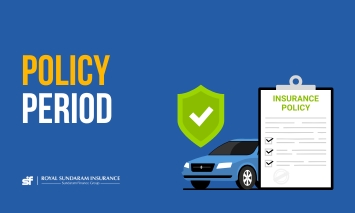IDV Explained
Mar 19, 2025 • 3 Min Read
Ever wondered how much your insurance company would pay if your car/bike were stolen or Total loss? That's where IDV, or Insured Declared Value, comes in. It's the maximum amount your insurer will pay for such a loss, and it plays a crucial role in both setting your insurance premium and receiving your claim. Let’s know in detail what is IDV in car insurance policies.
What is IDV in Insurance?
IDV, short for Insured Declared Value, represents the current market value of your insured vehicle. This is the maximum sum assured by the insurance company in case of theft or total loss, meaning your car is damaged beyond repair.
The primary purpose of IDV is to determine the compensation you receive from the insurer in the event of a covered claim. It also plays a significant role for insured vehicles as it directly impacts the cost of their insurance premiums.
A higher IDV reflects a higher perceived risk by the insurer, resulting in a higher premium you need to pay. Conversely, a lower IDV translates to a lower premium but also means receiving a lower payout in case of a total loss claim.
Understanding Your Coverage
In car insurance, what is IDV or Insured Declared Value? It represents the maximum compensation you'll receive from the insurer in case of total loss (theft or irreparable damage). It reflects the current market value of your insured car.
Key Components of IDV for Cars
- Manufacturer's Listed Selling Price (Ex-Showroom Price): This is the price quoted by the manufacturer, excluding taxes and registration charges.
- Depreciation: As cars age, their value depreciates. Insurers apply depreciation rates based on the car's age to determine the IDV.
- Accessories: The value of approved and declared aftermarket accessories can be added to the IDV, increasing the claim payout if they are damaged or stolen.
The formula for calculating IDV is:
IDV = (Ex-Showroom Price - Depreciation) + Value of Declared AccessoriesTips for Optimising IDV in Bike/ Car Insurance
- Regularly review and update IDV: As your bike ages, its IDV decreases. Updating your IDV periodically ensures you're adequately insured based on the bike's current market value.
- Compare IDVs offered by different insurers: Different insurers may offer slightly varying IDVs based on their own internal calculations. Comparing IDVs can help you find the best coverage at a reasonable premium.
- Consider add-on covers: Opting for add-on covers like a depreciation waiver can help minimise the impact of depreciation on your claim payout, even with a lower IDV.
By understanding what IDV is in bike/ Car insurance and learning the aspects of IDV, bike/ car owners can make informed decisions. It ensures they receive adequate financial protection in case of unforeseen circumstances.
Choosing the Right IDV Cover
Research the depreciated value of your car based on its age and model. Choose an IDV that reflects your car's value while considering the impact on your premium. Discuss your options with an advisor to understand the permissible IDV range and its impact on your specific situation.
Examples of IDV Cover Scenarios:
- Scenario 1: You own a 5-year-old car with an IDV of ₹5 lakh. The car is stolen, and you receive the full IDV amount for a replacement.
- Scenario 2: You own a 10-year-old car with an IDV of ₹2 lakh. The car is declared a total loss due to an accident, and you receive ₹2 lakh, potentially needing to cover additional expenses if the car's actual value was higher.
What is IDV cover in car insurance? Royal Sundaram offers benefits, like maintaining your No Claim Bonus when switching and protecting against inflation, choosing the right IDV remains crucial for optimal coverage and financial security. Remember, the best IDV selection is a balance between affordability and adequate compensation for your specific car and needs.
Key Takeaways for Insurance Consumers
- A higher IDV reflects a higher perceived risk by the insurer, resulting in a higher premium you need to pay. Conversely, a lower IDV translates to a lower premium but also means receiving a lower payout in case of a claim.
- In car insurance, IDV is calculated based on the Manufacturer's Listed Selling Price (Ex-Showroom Price), depreciation, and the value of declared accessories.
- In bike insurance, what is IDV in bike insurance - it primarily considers the depreciated value of the bike based on its age, manufacturer, model, and variant.
- Regularly reviewing and updating IDV, comparing IDVs offered by different insurers, and considering add-on covers can help optimise IDV in bike insurance.
Future Trends and Developments Related to IDV in Insurance
As technology evolves, insurers are exploring new ways to calculate IDV more accurately. With the advent of big data and analytics, insurers can leverage data from various sources to better understand the risk associated with a particular vehicle, leading to more accurate IDV calculations. Additionally, insurers are exploring the use of blockchain technology to improve the transparency and accuracy of IDV calculations. So do know what is IDV in vehicle insurance before you make your policy purchase.
Conclusion
In the world of car and bike insurance, Insured Declared Value (IDV) plays a crucial role. It represents the current market value of your vehicle, directly impacting the claim amount you'd receive in case of theft or total loss. A higher IDV ensures you receive fairer compensation, reflecting the true value of your vehicle. When choosing car insurance or bike insurance, consider providers who offer a transparent and flexible approach to IDV. Look for insurers who allow you to declare an IDV that accurately reflects your vehicle's value. This ensures you get the right coverage without overpaying for premiums. Explore car and bike insurance options from Royal Sundaram and ensure your ride is protected with the right IDV and comprehensive coverage.



Discover the perfect insurance plan for you!
Get your free quote now!
Get StartedBy Clicking on Get Started, You agree to our Terms and Conditions and override DNC/NDNC registration.
More like this
View more





.png)